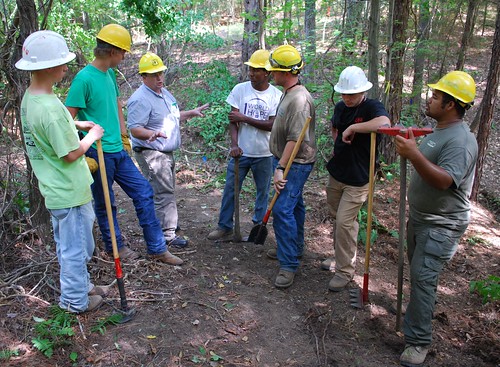
In today's technological society, children have retreated from outdoor activities -- bike riding, tree climbing or clinging to a rope swing to drop into a river -towards entirely virtual activities, indoor adventures at the end of a power cord.
A few years ago, researchers and educators gave this trend a name: nature deficit disorder.
In response to the trend, Joey Haney, principal of the smallest school in South Carolina, came up with an idea to get his 400-plus students unplugged and back outside. He consulted the school's environmental science teacher, Barry Morris, on the construction of a nature trail.
"The original idea was just to build a simple trail we could use for the school as a way to get the kids looking at the natural world, a sort of outdoor classroom," said Morris "We had a lot of ideas on where it could go, but no concrete plan. Then we started talking with the U.S. Forest Service and the plan began to evolve."
The Whitmire Community School contacted Enoree Ranger District Hydrology Technician Jay Swafford, who saw a unique opportunity for the agency to contribute to the community. He offered the help of the district's newly hired, four-person Youth Conservation Corps (YCC) crew to carve the trail out of a standing forest on the school grounds.

With the YCC crew handling the trail's construction, Haney and Morris were free to imagine ways in which every student in the school could benefit from the nature trail.
The school plans to have cross-curriculum involvement with the trail. The Industrial Arts program students will build a bridge. Art students can sketch natural landscapes or animals along the trail; students can perform plays in the outdoor amphitheatre; history classes can study the ways settlers and Native Americans used natural resources to make tools and live off the land; mathematics students can assist in calculating featured plots, measure slope or elevation or determine tree diameter, height or volume.
The trail will provide learning opportunities for the entire range of the school's population. Kindergarten students will learn about the use of the five senses as they observe the natural world. They'll learn to identify what living organisms need to stay alive - water, food, air and shelter - and study the impacts that changing seasons have on plants and animals.
Teaching points will become more complex at each grade level. Fourth graders will be summarizing the water cycle processes; studying evaporation, condensation and precipitation and the effects of runoff. They also will classify cumulus, cirrus and stratus clouds and learn how each is formed.
Older students will have the opportunity to explore careers related to biology, chemistry, geology and agriculture. They will gain exposure to forestry, aquatics and pond management, vegetable and flower cultivation, ecosystems and ethics as well as shelter and trail building.
District Ranger Beth LeMaster has always emphasized community involvement as part of the program, said Swafford. The interpretive trail fit that bill perfectly, and Principal Haney was quick to express his appreciation.
"The collaboration between the U.S. Forest Service and Whitmire Community School on this project is just a wonderful example of government agencies working together for the improvement of the community," Haney said.
Perhaps the most powerful inspirational force on any child's mind is natural curiosity, and the young YCC crew literally cleared a path for the education of future students in the workings of the natural world.
The lesson for a community of students and teachers within driving distance of the Whitmire Community School - all of whom are invited to experience its interpretive trail - is a lesson that teaches itself: the worlds at the end of the power cord may hold their wonders, but the woods at the edge of the trail can match them treasure-for-treasure, in the real world.
